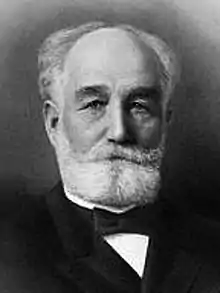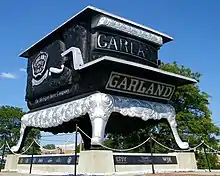Jeremiah Dwyer
Jeremiah Dwyer (August 22, 1837 – January 29, 1920) was an American businessman, industrialist, and manufacturer in Detroit, Michigan. He was associated with stove manufacturing for over five decades. Known as "The Stove King", Dwyer developed his first stove company in 1861. His firm later became the Detroit Stove Works as a joint stock company becoming a successful enterprise. That was reorganized later again with additional investors becoming Michigan Stove Company, the world's largest producer of stoves at the time. Besides running this company he was also a director of several other stove companies as well as a board member of several businesses in the Detroit area.
Jeremiah Dwyer | |
|---|---|
 Dwyer in 1903 | |
| Born | August 22, 1838 |
| Died | January 29, 1920 (aged 82) |
| Nationality | American |
| Occupation | businessman, industrialist, founder & director of firms |
| Spouse(s) | Mary L. Long |
| Children | 8 |
| Signature | |
Early life
Dwyer was born in the borough of Brooklyn in New York City on August 22, 1837.[1][2][3] He was the eldest child of Michael Dwyer and Mary (O'Donnell) Dwyer. He had a brother, James, and a sister, Mary. His father was born in 1800 and immigrated from Ireland to the United States when he was eighteen years old. He settled initially near Hartford, Connecticut.[4] He moved from Connecticut to Brooklyn two years later in 1820 and obtained management work.[1] Sometime in the mid-1830s he met and married a young lady who was from his hometown in Ireland. Their first child Jeremiah was born in Brooklyn. They moved to Michigan in October 1838 and established a farm in Springwells Township (originally "Belle-Fontai" - "Beautiful Fountain") about four miles (6.4 km) from Detroit.[5]
In addition to English, Dwyer learned French as a young boy since most of the family's neighbors in Springwells spoke French. Dwyer's parents worked a farm where his siblings James and Mary were born.[6][7] In 1848, Dwyer's father was killed after being thrown from a runaway wagon when the horses pulling it bolted after being frightened by the noise of a nearby train locomotive.[8] Dwyer then assisted his mother in managing the family farm for two years.[5][9] In 1850, his mother sold the farm and bought a home in the city of Detroit for the family.[10]
Mid-life
Dwyer and his siblings were home schooled for a while. In his teens Dwyer worked part time for Smith & Dwight's planing mill and attended Detroit public schools.[11] After graduating from high school he worked as an apprentice for four years in the molding trade at the hydraulic iron works of Kellogg & Van Schoick.[4][12][13] Dwyer became a journeyman after completing his apprenticeship and worked for three years at various foundries in the state of New York learning the stove business.[12][14] He then returned to Detroit and because of health issues resulting from intense work in poorly ventilated foundries, he changed fields for a while.[2] Dwyer took employment at the Detroit, Grand Haven and Milwaukee Railway for about a year.[14][15]

In 1859, Dwyer became a foreman at the Geary & Russell Foundry in Detroit and remained there until 1861. Then with his brother James and Thomas W. Misner, they bought out a small, failing reaper manufacturer trying to make stoves.[16] They turned the defunct manufacturer into "J. Dwyer and Company" that years later became the joint stock company Detroit Stove Works.[11][13] The stock holders were Dwyer and his brother James, W. H. Tefft, and M. I. Mills.[2] In 1871, Dwyer organized a new firm under the name Michigan Stove Company.[11][14][17] The stock holders of this company were Dwyer, Mills, R. H. Long, George H. Barbour, and Charles DuCharme.[2] The company grew to become the largest manufacturer of stoves in the world by 1905.[18]
George Harrison Barbour, the vice president of Michigan Stove Company, gave Dwyer the idea to construct the World's Largest Stove for the 1893 Chicago World's Fair and had his plant superintendent William J. Keep design the mammoth Garland kitchen range that weighed 15 short tons (14 t).[19][20][21]
Personal
Dwyer married Mary L. Long on November 22, 1859.[2] They had eight children, seven sons and one daughter. Their names were: James W., John M., Elizabeth B., William A., Francis T., Vincent R., Gratton L., and Emmet.[22] Dwyer liked traveling to Europe for vacations. In Detroit his office address was at 1022 Jefferson Avenue and his residence was at 692 Jefferson Avenue.[23] He held a membership in the Detroit Country Club.[24] Dwyer associated with the Democratic Party and was a Catholic.[22]
Businesses and associations
Dwyer served as a member of the Board of Estimates for two terms. He was a trustee of the Fire Department Society.[2] For twenty-four years Dwyer was a commissioner and inspector of the Detroit House of Corrections.[11] He was one of the founders the People's Savings Bank and a director of the Peoples State Bank of Detroit. He was a board member of Michigan Stove, Peninsular Stove, Art Stove, Buck's Stove, Michigan Copper & Brass, Michigan Fire and Marine Insurance, Security Trust, and Ideal Manufacturing of Detroit.[11] Dwyer was known as "The Stove King" when he operated the stove companies.[25]
Later life and death
Dwyer suffered various illnesses for years, which toward the end of his life caused him to withdraw from his business affairs. He died at the age of 82 on January 29, 1920. At the time of his death he had four sons and one daughter still living. They were John M Dwyer, William A Dwyer, Emmett Dwyer, Grattan L Dwyer; and Mrs Elizabeth B. Smith of Cleveland. His wife had died in 1919.[11] He is buried in Mount Elliott Cemetery in Detroit, Michigan.[26]
References
Citations
- Bersey 1890, p. 248.
- Biographical 1900, p. 462.
- Farmer 1890, p. 1187.
- Founding 1920, p. 163.
- Catlin 1898, p. 697.
- Taylor 1909, p. 416.
- "James Dwyer is dead at 69 yrs". Detroit Free Press, vol. 76 - No. 357. Detroit, Michigan. September 18, 1911 – via Newspapers.com
 .
. - Farmer 1890, p. 1188.
- "Detroit Men of Achievement". Detroit Free Press. Detroit, Michigan. November 8, 1903 – via Newspapers.com
 .
. - Moore 1915, p. 682.
- Stern 1920a, p. 31.
- "Jeremiah Dwyer - Pioneer in one of Detroit's greatest industries". Detroit Free Press, part 4. Akron, Ohio. September 2, 1906 – via Newspapers.com
 .
. - Burton 1922, p. 546.
- Taylor 1909, p. 417.
- Derby 1894, p. 300.
- Loomis 2012, p. 99.
- "Encyclopedia Of Detroit - Detroit Stove Works". Detroit Historical Society. Retrieved January 7, 2020.
- "The Truth About Stoves". Detroit Free Press. Detroit, Michigan. October 20, 1905 – via Newspapers.com
 .
. - "When stoves were the hot new thing". The Detroit News. Retrieved January 7, 2020.
To grab attention at the Chicago World's Columbian Exposition of 1893, George H. Barbour, vice president of the Michigan Stove Co., had his woodcarvers replicate on a gigantic scale a Garland brand model kitchen range built by the firm. Factory superintendent William J. Keep designed the huge stove and had it carved in oak. It measured 25 feet high, 30 feet long, and 20 feet wide. Painted to look like metal, it stood at the Chicago exposition on a platform 20 feet high over an exhibit of regular stoves. The Michigan Stove Co. built a gigantic, 25 feet high, 15 ton wooden replica of a Garland kitchen range, painted to look like metal, for the Chicago World’s Columbian Exposition of 1893.
- "Seeking Michigan". Seeking Michigan. Retrieved January 7, 2020.
George H. Barbour, vice-president of the Michigan Stove Company, conceived the idea for this giant replica stove. He used it to promote the company’s "Garland" model at the 1893 Columbian Exposition in Chicago. William J. Keep designed the replica, sculpted from oak by John Tabaczuk and Joachim Jungwirth. The massive oaken replica stove was painted to appear metal, weighed fifteen tons, measured twenty-five feet high, thirty feet long and twenty feet wide.
- "The Town Crier". Detroit Free Press. Howell, Michigan. February 18, 1965. p. 60 – via Newspapers.com
 .
. Fact supplied by the Detroit Historical Commission credits George Barbour, then vice president of Michigan Stove,with the idea for the stove to be built and displayed at the Exposition to dramatize Detroit's position as "stove capital of the country." It was designed by the superintendent of Michigan Stove, William Keep. Constructed of oak, it stands 25 feet high, is 30 feet long 20 feet high, weighs 15 tons.
- Taylor 1909, p. 418.
- Hamersly 1909, p. 539.
- Marquis 1908, p. 155.
- Collins 1914, p. 4.
- Jensen 2006, p. 29.
Bibliography
- Bersey, John (1890). Cyclopedia of Michigan. Western Publishing & Engraving. OCLC 707170143.
- Biographical, Press (1900). The Successful American, V.3. Press Biographical Company. OCLC 659052083.
- Burton, Clarence (1922). City of Detroit, V.1. S. J. Clarke Publishing Company. OCLC 312656467.
- Catlin, George (1898). Landmarks of Detroit. The Evening News Association. OCLC 977301926.
- Derby, George (1894). The National Cyclopedia of American Biography, Volume 5. J. T. White. OCLC 140483631.
- Farmer, Silas (1890). Detroit & Wayne County. S. Farmer & Company. p. 1184. OCLC 38301253.
- Founding (1920). Foundry, Volume 48. Penton Publishing Company. OCLC 890626508.
- Hamersly, L.R. (1909). Men and Women of America: A Biographical Dictionary of Contemporaries. L. R. Hamersly. OCLC 1011946917.
- Jensen, Cecile Wendt (2006). Detroit's Mount Elliott Cemetery. Arcadia Publishing. ISBN 0738540935.
- Loomis, Bill (2012). Detroit's Detectable Past. Arcadia Publishing. ISBN 978-1614236276.
- Marquis, Albert (1908). The Book of Detroiters. Albert Nelson Marquis. OCLC 810044327.
- Moore, Charles (1915). History of Michigan. Lewis Publishing Company. OCLC 657081089.